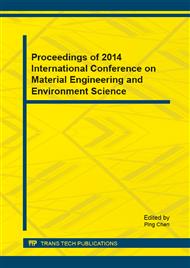p.22
p.28
p.33
p.40
p.44
p.50
p.55
p.60
p.65
Research on the Plant Selection of Buffer Zone and Pollutants Removal Ability of Plants in Ashi River Basin
Abstract:
Eight aquatic plant species commonly found in northern China were studied on their removal ability and enrichment ability of nitrogen and phosphor in root, stems and leaf through the pot experiments. The result shows that when the concentration of TP and TN in entering water is ranged from 0.29 to 0.46mg/L and 4.69 to 4.74mg/L respectively, Lythrum salicaria, Iris pseudacorus and Typha angustifolia have the higher removal rate of TP, which increased by 18.61%, 17.8% and 16.44%, respectively, compared with the blank; Typha orientalis Presl, Phragmites australis and T. angustifolia have the higher removal rate of TN, which increased by 21.10%, 21.81%, 21.64%, respectively, compared with the blank. L.salicaria has the best removal ability of TP, the removal rate of TP in root,stem and leaf arrived at 3.57%, 2.13% and 3.34% compared with control. T.orientalis Presl has the best removal ability of TN. Among the test plant species, L.salicaria, T.orientalis Presl and T.angustifolia are the best one for the water purification in Ashi River basin.
Info:
Periodical:
Pages:
44-49
Citation:
Online since:
November 2014
Authors:
Keywords:
Price:
Сopyright:
© 2014 Trans Tech Publications Ltd. All Rights Reserved
Share:
Citation:


